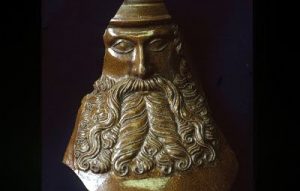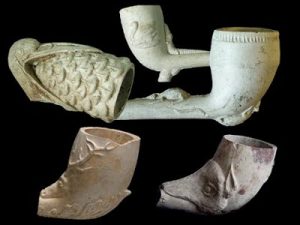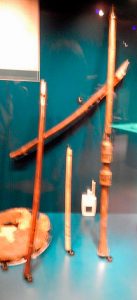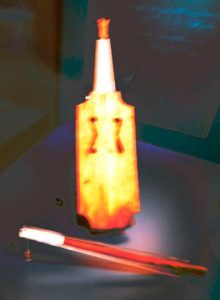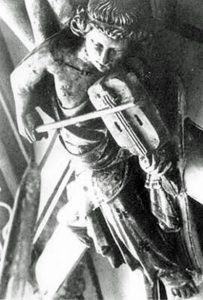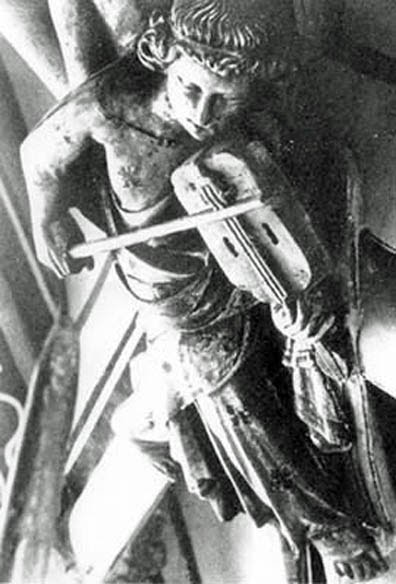
No 520 July 2014 Edited by P & K McSharry
HADAS DIARY – Forthcoming Events: –
The Hendon and District Archaeological Society presents
Getting to grips with Pots & Pipes: the archaeology of everyday artefacts from
Saxon times to Queen Victoria
with Jacqui Pearce BA FSA MIfA on Saturday 2nd August 2014
at Stephens House and Gardens 17 East End Road, Finchley, London N3 3QE from 10.00am to 4.00pm
For the archaeologist, pottery and clay tobacco pipes are among the most common finds made during excavation. This one-day workshop aims to provide an introduction to identifying these ubiquitous artefacts, and to understanding their role in the everyday lives of the people who used them, through specialist-led presentations and handling sessions.
Attendees are also invited to bring along finds for identification. The workshop will consist of presentations in the morning, on medieval and post-medieval pottery, and in the afternoon on clay pipes. A number of finds-handling sessions have been built in throughout the day.
Jacqui Pearce is Senior Specialist, medieval and later ceramics, at MOLA (Museum of London Archaeology).
Tickets cost £20 which includes morning coffee, buffet lunch and afternoon tea.
************************************************************************************************************************************************************************************************
Hendon and District Archaeological Society (HADAS) is pleased to invite HADAS members to the launch celebration of its latest book:
“A Hamlet in Hendon. The archaeology and history of Church End from excavations at Church Terrace, 1973 – 74”
When Themistocles Constantinides founded HADAS in 1961 it was with the main aim of finding and proving the Anglo-Saxon origins of Hendon. In 1973 an opportunity arose to excavate at Church Terrace that finally proved the ancient origins of this part of Hendon. Now, 40 years later, this exciting book brings together all the evidence from that excavation and relates the story of one of the original hamlets that made up the parish of Hendon. This beautifully produced book, at over 200 pages, has maps, diagrams and analysis of the excavation and the related finds, and is packed with full-colour photographs.
Don Cooper, our HADAS Chairman has written in his introduction “We are hugely proud of this book. It is not only a record of the excavation and post-excavation analysis of this site, but is also a major contribution to the history, origins and development of Hendon. It is a fine example of what
local archaeological societies can still achieve.”
HADAS will formally launch the publication of this book at an event on Sunday August 3rd 2014, from 1.30 p.m., at “The Greyhound” public house, Church End, Hendon, NW4 4JT, close to the site of the excavation. In addition to receiving free copies of the book, members of HADAS will be available to discuss the book and the wider activities of HADAS. Light refreshments will be available.
As a HADAS member, we are delighted to invite you to this event and we hope that you will be able to join us. For our planning we would be grateful if you could confirm your attendance by contacting Jo Nelhams, HADAS Secretary, on 020 8449 7076, secretary@hadas.org.uk, or write to her at 61 Potters Road, Barnet Herts EN5 5HS.
Annual General Meeting – Tuesday 10th June 2014 Jo Nelhams
The 53rd Annual General Meeting was held on Tuesday 10th June at 7.45pm in Avenue House (now Stephens House). I would like to thank all those who came along to this rather special AGM to
celebrate the publication of the HADAS book, ‘A Hamlet in Hendon’.
The meeting was attended by 36 members with apologies from a further 14.
The Chairman, Don Cooper opened the meeting announcing the recent death on May 10th of John Enderby, a founder member. He also offered apologies from the President Harvey Sheldon, who was indisposed.
Peter Pickering, the Vice Chairman, took the chair to conduct the business of the re-election of Don Cooper as Chairman, which was unanimously approved. Don took the Chair for the remainder of the meeting.
All other officers and members of the Committee offered themselves for re-election.
The Committee consists of Chairman: Don Cooper, Vice-Chairman: Peter Pickering, Hon. Treasurer:Jim Nelhams, Hon. Secretary: Jo Nelhams, Hon. Membership Secretary: Stephen Brunning, and committee members Vicki Baldwin, Bill Bass, Roger Chapman, Eric Morgan, Andrew Selkirk, Tim Wilkins, Sue Willetts and Simon Williams.
The Chairman explained the changes at Avenue House. Avenue House is now to be known as ‘Stephens House & Gardens’ Our use of the Garden Room and Garage will cease, but we have been allocated alternative accommodation in the basement, which is large enough to store the contents of both the Garden Room and Garage. The rent will remain the same and will be held for 3years.
The meeting closed at 8.12pm.
Post AGM.
Last September Jim and I attended the first LAMAS conference on Historic Buildings. Harvey
Sheldon gave a short, but very interesting, presentation about the London Walls. As he attends our AGM to chair the meeting, we asked if he could do a similar lecture for us and he kindly agreed. However, the best-laid plans sometimes have a hitch. Unfortunately Harvey was unable to attend, but miraculously he managed to engage at very short notice John Shepherd with whom he had been working on this topic. Our grateful thanks go to John for his contribution.
A report of the lecture follows.
After the lecture copies of the recently published HADAS book ,’A Hamlet in Hendon’ were distributed to the members who were present, with some liquid refreshment to celebrate the occasion.
Many thanks to everyone for a memorable evening, a special AGM.
The City Wall of London by John Shepherd Liz Gapp
John started his well-illustrated talk by showing the familiar outline of the city walls of London. He explained that current conventional thinking suggested that the date of building for the land wall side was fairly inexact, from 180 to 240 AD. The riverside wall was more precisely estimated at 270 AD. If this is true it implies a few generations difference between the times of building the two different parts of the wall.
The first point raised was to consider whether Londinium was always the shape we assume it to be today.
In 1944, as peace approached, Kathleen Kenyon, then acting director and secretary of the Institute of Archaeology, noted that restoration of the bombed City of London ruins gave an opportunity for archaeological work to provide a greater understanding of the origins of London. The first suggestion was that it was the Roman elements that should be pursued. Professor Grimes, who replaced Mortimer Wheeler as Director of the Museum of London, pressed for both Roman and Medieval to be pursued, and Ivor Noel Hume specifically traced the Medieval origins.
In the 1940s, it was known that the original city wall was Roman, but precise knowledge of when it was built was not known until Professor Grimes, via his archaeological ‘interventions’ was able to narrow it down in the 1950s.
John’s interest in the problem started in the 1980s, when he was research assistant to Professor Grimes. Through a series of small strategically placed trenches, Grimes had been able to identify the Cripplegate Fort, within the NW corner of the city walls, as a standard ‘playing card’ shape similar to those on Hadrian’s Wall. This could be read as part of Hadrian’s reorganisation of his administration network, for use by the Roman military who were the civil servants of the day. Grimes dated it to c.120 AD, before any probable date for the walls themselves. He was most proud of this set of excavations, and would have preferred his CBE to have been awarded for this out of his more than 45 excavations in the area, rather than his discovery of the Mithras temple for which he actually won the award. He considered this latter excavation to be just pure luck, whereas the identification of the fort was as a result of educated hard work.
With the architecture of the fort shown to be the same as that used on Hadrian’s Wall, Grimes was able to work out the proportions and located the fort’s western gate, which later became one of the six City gates. This was published together with Audrey Williams, the unsung heroine of Grimes’s days
The city walls near the Cripplegate Fort were very well designed, with the North-South wall following the fort walls exactly. Mortimer Wheeler’s notes on the city wall in the fort area also said that it was built over an existing Roman wall.
In 1946, at Bastion 14, it was noticed that two walls had a Commodus coin stuck in the mortar, giving a date for construction as after 180 AD, the date of the coin. It was also noticed that at some points the Roman wall had a second later wall built exactly alongside it. At St Alphage, it is possible to see the join of the fort wall against the city wall.
The West Gate had large 12 inch blocks at its base which showed signs of being worked.
Interestingly, when Bazalgette’s sewer was being built in London, the men often came across parts of the old London walls. As it affected their work rate, a plan was kept of these.
Excavations at St Paul’s tube station uncovered a concrete foundation that was so solid it needed explosives to destroy it. The solidity of it suggests that there could have been a triumphal arch there – was this an earlier entrance to the city?
The later City Wall was constructed in the 9th to 11th century. Interestingly, while in this later era there was a great quantity of rubbish pits, none of them were near the West Gate, implying that it was still in use then. It was not until Neville’s House was built in the 13th century in that area, and across the West Gate, that it was blocked up.
To summarise; the West and North walls look like defensive walls. Evidence elsewhere shows that the city gates pre-dated the city walls, which look to have joined up the gates, so formalising the status of the city. In places, the direction of the wall in relation to the gate seems to bear this out. The earlier Commodus coin gives a terminus post quem date for the wall. Part of the ditch is dated to the late 2nd to start of 3rd century and has a cut culvert dated to the late 3rd and 4th century. This means the early 3rd century is missing.
The date of 220 AD as the latest date for the land wall, which Peter Marsden suggests, comes from the discovery of coin moulds and coins dated 220 AD, which were found in the cut. So this was apparent good evidence for this date. However, the amount of debris identified with the coins and moulds suggest this is a later dump from elsewhere, so cannot be used as a dating baseline. Dendrochronology from the riverside wall suggests a date of 270 AD as the main construction date for the riverside wall.
Examination of the structure of the whole city wall shows it to be consistent; with a red brick base, Kentish ragstone on top of this, topped with more red bricks.
The proposed new theory by Harvey and John is that, looking at the structural evidence, it is probable that the whole wall was built at the same time – so the land wall was not built until 270 AD. This begs the question as to why, all of a sudden this was considered necessary.
To consider this, a look at the social history of the time is necessary. Britain was a major supplier of grain for the Roman Empire. This meant that it became very wealthy. However, if the list of Emperors is examined, it can be seen that this era was also very turbulent with many short-lived Emperors, often in competition with each other.
This great grain wealth led to many late Roman buildings in Britain and a lot of silver being used there. However, the great rivalry for these supplies meant that a chain of Saxon shore forts were built to protect them, as the great rivalries in the elite hierarchy meant that whoever had access to these supplies was in the strongest position.
The Ammianus Marcellinus ‘Res Gestae’ Book XVIII Chapter 2-3 gives detail of this.
This unrest is one of the bases for concluding that it was much more logical for the building of the wall to have been one ‘short’ continuous event rather than two separated by generations.
John concluded by saying ‘watch this space’ as he and Harvey are still researching this theory.
The Bishops of London Hunting Park and Lodge Malcolm Stokes
In his lecture to HADAS on Tuesday 13th May Malcolm Stokes gave us a full account of what is known about this somewhat enigmatic medieval feature. Malcolm is a local historian who has long served on the Publications Committee of the Hornsey Historical Society. He has a keen interest and extensive knowledge of the Hornsey and Haringey areas. His particular field is parish boundaries as evidence of ancient roads and properties.
Medieval churchmen, often of high birth, loved the sport of hunting as much as other members of the nobility. The existence of a Hunting Park and Lodge in north London belonging to the Bishops of London is well known, though there is relatively little recorded evidence of its existence and exact location. The earliest is a deed of 1227 granting land in St. Pancras parish. It refers to a property adjoining the “Bishops’ Park”. Other documents exist, which were sealed or given at the park. One dated 1335 is the last of these. In 1390 tolls for the area were farmed out to one William Payable, which is taken to be evidence that the park no longer belonged to the Bishops of London.
During the 15th century the Lodge itself figured in a conspiracy against Henry VI. Eleanor of Cobham, wife of Humphrey, Duke of Gloucester, was accused of having consulted with astrologers and one Margery Jourdemayne in order to precipitate the death of the king, thus allowing her husband to ascend the throne. This conspiracy is said to have taken place at the Bishops’ Lodge. Shakespeare mentions it in “Henry VI, Part II”, but sets the meeting of the conspirators in the Duke of Gloucester’s garden.
John Norden, in his description of Middlesex of 1593, mentions the park and it appears on his map as “Lodge Hill.” Other current local names, such as Bishops Avenue, also relate to its existence.
Malcolm Stokes demonstrated how he has traced the outlines of the park. Ancient enclosures often followed parish boundaries. With the aid of photos and maps we were shown the probable position of the woodland. It straddled the parishes of Hornsey and Finchley and had three gates. From one of these, the “High Gate”, now the “Gateway” pub, the boundary ran north along the course of Southwood Lane, and then across the Archway Road towards Highgate Wood. At this stage it followed the edge of the high ground to the left (west) and the steep drop to the right (east). The enclosure then turned west along the northern edge of Highgate Wood. A second gate probably stood where the railway crosses the old Great North Road at East Finchley. The boundary then curved southwest and finally south towards the Spaniards Inn, site of the third gate. From there it ran east along a line just south of Hampstead Lane along the former parish boundary. The present road is just north of this and dates from the building of Kenwood House. A sunken ditch near the latter’s restaurant is probably a visible sign of the enclosure.
The site of the Bishops’ Lodge buildings is thought to be shown by several ditches on Highgate Golf Course, enclosing an area of 70 foot square. It will have been a substantial building, large enough to house the bishop and his retinue. John Norden mentions ditches 70 foot square and debris of “brick tile and Cornish slate”. Though it would be fascinating to investigate this feature with modern archaeological methods, it is not likely that permission for this would ever be given.
This lecture on a piece of local history was not only most instructive, but may well evoke images of a medieval hunt on future walks in Highgate Wood.
Visit to Portsmouth Historic Dockyard and Harbour Jim Nelhams
On Thursday 15th May, our gold coach transported us to Portsmouth for a visit to the dockyard. Our pilot was Gary, who looked after us so well last year on our trip to Buxton.
The Historic Dockyard is within the Royal Naval dockyard and the Victory is still on the Royal
Navy list having not been decommissioned. Although our main purpose was to visit the new Mary Rose Museum, opened late last year, there are lots more things to see, including Nelson’s Victory and HMS Warrior. Our tickets allowed us access to all of them, including a harbour boat tour, giving us the chance to follow particular interests.
The Mary Rose Museum, while it has display cabinets as you would expect, makes maximum use of the hull that was raised from the Solent. After an initial introductory display, the route uses glass lined corridors at the level of the various decks. On one side is the hull itself, currently still being treated and visible through carefully located windows. On the opposite side are displayed many of the finds from the wreck positioned directly opposite the relevant part of the ship, such as the carpenter’s cabin and the surgeon’s cabin. All of the items are originals – no replicas needed. Such is the volume and variety of finds that it would be easy to spend a whole day in the Mary Rose Museum without looking at anything else.
The following notes show how wide these interests go.
The Harbour Andy Simpson
No-one touring the dockyard, or those lucky enough to take the harbour tour, could miss the area being dominated by a former aircraft carrier and several of the Royal Navy’s remaining Destroyers and Frigates.
Biggest of these was former aircraft carrier R06 HMS Illustrious – the ‘Lusty’ to her crew – nowadays called an ‘Amphibious Ship-Landing Platform Helicopter’ but still retaining the bowmounted ski jump from her days launching Sea Harriers before HM Government decided if something had to go it should be the Harriers (and Nimrod maritime reconnaissance aircraft) rather than the Tornado force. Weighing in at 20,000 tonnes she is the last survivor of a class of three, including the late lamented Ark Royal, since scrapped on an Indian beach.
Lying immediately ahead of her was one of our total destroyer force of six, D36 HMS Defender of the new Type 45 Daring Class. A hefty-looking 7,350 tons with a crew of 191, she mounts a rapidfiring 4.5 inch gun – very useful for shore bombardment, as proved in the Falklands War – and a Lynx or Merlin helicopter in her aft hangar.
Also in the line-up were two or three Type 23 Frigates, including F229 HMS Lancaster, hosting a ceremony of some sort. Weighing in at 3,500 tonnes and mounting the usual 4.5 inch gun and Lynx or Merlin helicopter as well as Harpoon anti-ship missiles. There are 13 of this class, which often pop up in the news after another successful anti-drugs patrol in the Caribbean, for instance. See http://www.royalnavy.mod.uk/the-equipment/ships
A rather smaller and older vessel was the partly restored, dry-docked Gallipoli veteran Monitor M33, owned by Hampshire Museums Service.
See http://www.historicdockyard.co.uk/news/news519.php
The Warrior Andrew Coulson
Personally, I thought that the Warrior was magnificent but, in many respects, she was a one week wonder. As a result of her invulnerability and offensive power she compelled the navies of the World to abandon sail and to invest heavily in research into iron hulls, armour, engines, speed, armour piercing shells and gun range, a process that continues to this day.
Before the Warrior, navies had not changed much from the time of the Mary Rose, some 330 years previously. While differing in degree, but not in principle, they had stayed roughly the same. After the Warrior, they could not afford to.
The Spinnaker Tower Ruth Wagland
I have seen the Spinnaker tower several times from cross channel ferries and admired it greatly, the opportunity to actually go up the structure was too good to miss. After I had absorbed as much as I could of the wonderful Mary Rose exhibition I walked the short distance to the tower.
It’s 170 metres high, the centre piece of the Portsmouth harbour redevelopment. The lift goes swiftly to the first of the three viewing platforms after which the other two are reached by stairs. The top platform is open to the sky with a mesh covering. The views from each platform are spectacular with a 360 degree view from the top. There is a ‘Sky Walk’ with a glass floor of 4 panes, each measuring 205 x 95cm, nearly 8 square metres in total, which is 100 metres above sea level giving a dizzying view below.
Altogether a great addition to a terrific day.
Kismet? Jean Lamont
I happened to reach the top deck of the Victory in time to hear one of the Guides giving a very graphic account of the death of Nelson on exactly the spot where he is supposed to have been struck down (commemorated by a brass plaque). He described how Nelson always appeared during a battle dressed in all his honours – four orders of chivalry and other medals from earlier campaigns (or “bling” as the guide described it!) to establish his authority and encourage his troops, so he made a fairly easy target for any sniper. However the guide maintained that all the smoke generated by the battle would have made it a very difficult task to pick out any individual, and so did not believe that Nelson had been deliberately targeted, but it was simply a lucky shot. He said that the French climbed up into the rigging and fired downwards (which the English troops were forbidden to do, because of the risk of fire) and detailed all the organs the shot hit on its trajectory down through Nelson’s body! Nelson was carried below and died three and half hours later, Hardy relaying the news of the progress of the battle to him throughout the afternoon.
He dismissed the idea that Nelson might have said “Kismet, Hardy” as the word did not enter the English vocabulary until many years later, but it was not unusual for men to kiss in those days and it would not have been thought strange for him to ask Hardy to kiss him.
On the Mary Rose, I particularly liked the collection of musical instruments and the interactive display which enabled visitors to listen to the sound of the instruments in tunes of the times.
Musical Instruments Tessa Smith
What caught my eye at the Mary Rose was a small display of musical instruments, a tabor (drum), three pipes, fragments of two fiddles and an exciting discovery – a doucaine, an early form of oboe. These musical instruments were found in the orlop (good word for scrabble), the bottom deck of the ship, above the hull, and had probably been packed away until needed as entertainment for the ships crew. Sadly they were never unpacked.
The melody was played on the pipes and the rhythm on the tabor to entertain the crew with sea shanties and work songs. I can imagine the sailors singing “I’ll go no more a ‘roving with you sweet maid” and dancing the sailors hornpipe, that is if they were written or invented in the 16th century. (Does anyone know?)
This little tableau of early instruments brought to life for me another layer of the Mary Rose experience.
Musical Instruments (continued) Jo Nelhams
The Mary Rose had kept hidden many secrets until its lifting from the depths of the Solent in 1967. Early musical instruments are rare and little was known of the doucaine. The shawm, an early form of the oboe, is well documented. The doucaine is mentioned in literature between 13th and 17th centuries, but an actual example was unknown until the instrument was discovered on the Mary Rose. The doucaine has a cylindrical bore like a clarinet, whereas the shawm and oboe both have a conical bore. The doucaine has a double reed, as does an oboe today, but its tone is more subdued, like that of a clarinet.
There are only about 60 recent replicas in the world, just as rare are the people who can play them.
There were also parts of two fiddles on board. There are only three known examples of the old fiddles and two of these were found on the Mary Rose. Their body is more angular than a violin.
The oldest known example of this kind of instrument is the Angel musician in Gloucester Cathedral circa 1280.
Skeletons in the cupboard Liz Tucker
We’ve always been interested in the Tudors, mainly because of the music, so were very keen to see the Mary Rose. It’s nice to remember that Henry VIII did other things besides getting married, beheading people and closing monasteries.
Having studied biology, I was particularly fascinated by the way you could reconstruct people’s lives from their bones, either from their injuries, or deformities caused by their way of life (from the archers to the cooks), and by the film of the facial-reconstruction expert.
It is also possible to work out where crew members came from, and what they ate, by the isotopes in their bones. I was slightly disappointed that this was only touched on at Portsmouth, but a smaller exhibition in Croydon some years ago went into more detail, stating that many of the crew came from Spain. Presumably the Spanish were Henry’s allies against the French, at that time; he would be on to his sixth wife by then, so the Spanish might have forgotten how he treated the first one. (Andrew pointed out that you could also deduce that the crew were not all English, from the rosaries found on board.)
Bows and arrows Dot Ravenswood
The sheer size of the bows we saw was astonishing. Made from yew staves between 168cm and 183cm long, they were so heavy to draw that men who used them regularly developed larger muscles on their left side, which took most of the strain when they braced the bow, than on their right. Some of the 172 longbows raised from the ship were found at the archers’ posts behind the gunports, while others were still lying in their boxes. Nearly four thousand arrows, between 71cm and 76cm long, were found, and some of these were on display, fletched with substitutes for the original goose or swan feathers. We also saw some of the leather spacers in which the arrows were kept ready for use, and the bracers or armguards worn by the bowmen. While there would have been a group of specialist archers on board, most of the crew would have been capable of shooting with a bow and arrows to a distance of 200m, since that was the required qualification for military service. All landsmen over the age of seven were obliged to practise regularly at the butts, where the targets were set up; and perhaps that’s how the archers’ jargon entered common speech. When we say that somebody was the butt of jokes, or needed another string to his bow, we are using archery terms.
And other finds Simon Williams
Among the 18,000 artefacts found aboard – of particular interest were – a rare circular shield with a hand-gun in its centre, the skeletal remains of a rat and the ship’s small whippet-like dog. There was also a huge cauldron for cooking; the oldest surviving crow’s nest from a mast, complete with a large arrow-like missile for hailing explosives or fire down onto the enemy and their sails.
Surprising for exclusively sea battles, there were many pikemen, bill-hookmen and archers on board. This was to repel the enemy from boarding. Some gun carriages were in particularly good condition and together with their guns they made a fine display.
Of a crew of 700 (usually 415), only 35 survived. Most couldn’t swim.
Unanswered questions Andrew Tucker
In the Mary Rose exhibition they did not give the end of the story of the Battle of the Solent. They said that the French had an invasion fleet bigger than the Spanish Armada, but not what happened to it after the Mary Rose sank.
According to Wikipedia they landed some troops on the Isle of Wight, had a couple of skirmishes with English forces and then went home.
One of the exhibits was a ruler. The description said that Tudor inches were smaller than modern ones. Is that right? It implies that their feet, yards…miles were also smaller. When did the inches get bigger?
A good day out, although I could have done with a couple more hours on the site.
How to get there Jim Nelhams
While the tickets are quite expensive, they give good value for a full day visit. Should you wish to visit yourself, the dockyard entrance is less than ten minutes’ walk from Portsmouth Harbour station with direct trains from London Victoria – but make sure you are in the right carriage as the train splits at Horsham.
Individual dockyard tickets allow you to return again within one year.
Thanks to all our contributors for their excellent and very varied homework!!! Well done.
Other Societies’ Events Eric Morgan
Tuesday 8th July. 7.45pm Amateur Geological Society. The Parlour, St. Margaret’s Church, Victoria Ave, N3 IBD (off Hendon Lane). ‘The Pros and Cons of Fracking in the UK’. Talk by Prof. Peter Simpson (Imperial College).
Saturday 12th July, 9.00am. Barnet Museum & Local History Society. Coach outing to Chatham Historic Dockyard where there are numerous attractions to visit and ships to board at your leisure including: – the Victorian Ropery, submarines, historic warships, lifeboats and the Smithery – with collections from 2 national museums. There are plenty of places to eat and areas to picnic. Leave Barnet Odeon, Great North Road including Station Road 9.00am. Leave Chatham 5.00pm. Cost £26 (includes entrance fee to Dockyard). Send cheques to Pat Alison at 37, Ladbrooke Drive, Potters Bar, Herts EN6 1QR (tel No: 01707 858430) stating your name, address & telephone number. If receipt required SAE or email patron37@sky.com or telephone Barnet Museum on 0208 440 8066.
Wednesday 16th July, 7.30pm. Willesden Local History Society. Tour of St. Mary’s Churchyard & Church. Led by Margaret Pratt & Cliff Wadsworth, including a short walk around the grounds and an informal talk in the church. Meet at the bottom of Neasden Lane, NW10 2TS (nr. Magistrates Court) junction with High Road.
Sunday 20th July & Saturday 9th & Sunday 10th August, 2.00pm. Crouch End Walks – World War 1 Tours of Crouch End. Led by Oonagh Gay & Paul Sinclair. Topics covered include: the war memorial, conscientious objectors, auxiliary hospitals, rationing, zeppelins & Gotha bombing & the Belgian refugees & German & Austrian internees in Alexandra Palace. Lasts 2 hours. Meet at cnr of Middle Lane/Priory Road, N8, nr. Priory Road entrance & mini roundabout. Cost £7 & after there is tea and cake £3 at the Earl Haig Hall in Elder Ave, N8. Places are going fast & reservation is essential. E-mail crounchendwalks@btinternet.com or phone 07539 399549 and pay on the day. The walks draw on the archives of the Hornsey Historical Society.
Sunday 20th July, 11am – 4pm. Headstone Manor Excavations. Pinner View, North Harrow, HA2 6PX. Public Open Day. Tours of the dig, displays, medieval re-enactments & hands-on activities. Free admission. (see previous newsletters for further details & information).
Sunday 3rd August, 2.30pm. Heath & Hampstead Society. Sandy Heath & the Heath Extension.
Meet at the cattle trough & flower stall, Spaniard’s Road, NW3 (nr Spaniard’s Inn). Walk led by Lynda Cook (HHS). Lasts approx 2hrs. Cost £3.00.
Saturday 2nd – Saturday 9th August. Avenue House (now Stephen’s House) East End Road, N3 3QE. World War One Week. Avenue House was commandeered during WW1 as a hospital. There will be varied events, exhibitions & activities in the house & garden. A poppy garden will be planted in the rockery. There will also be a French Casualty Clearing Diorama on display.
Friday 8th August, 9.00am. Mill Hill Historical Society. Coach trip to Tunbridge Wells &
Scotney Castle, visiting Tunbridge Wells’ famous Pantiles Arcade. Scotney Castle is a National Trust property near Lamberhurst, Kent and is a mixture of old & new with its glorious 770 acres of gardens. Depart St. Michael’s Church, Flower Lane NW7 at 9.00am. Latest date for booking is
Wednesday 9th July to Keith Dyall, 26 Millway, NW7 3RB. Price including entry to castle is £27.00 (£16 for N.T. members. Email: keith.dyall@btinternet.com ). Phone 020 8959 7147/07788 677103. Please send S.A.E together with cheque payable to Mill Hill Historical Society stating your name & telephone number. Don’t forget to bring your National Trust membership card if appropriate.
Saturday 9th – Wednesday 13th & Monday 18th – Friday 22nd August. WEAG & Copped Hall Trust – Archaeological Project Field Schools 2014 – continuing excavations of the Tudor Grand
House, near Epping Forest. Cost £90 per week (non-residential). Course Directors Christina Holloway, Lee Joyce, John Shepherd (who spoke at our AGM). For further information & to book contact: Andrew Madeley (Tel no: 020 8491 6514, e-mail coppedhalldigs@weag.org.uk or access www.coppedhalltrust.org.uk or www.weag.org.uk/eventsfieldschool_html
Sunday 10th August, 2.30pm. Enfield Society – Heritage Walk around Bush Hill Park. Led by Joe Studman. To see five grade II & four locally listed buildings, passing the Anchorage, Brooklyn, Castleleigh and the Clarendon Arch (over New River). The history and personalities associated with them are explained along with many other stories. Lasts 90 minutes. Please send S.A.E. for tickets to Heritage Walks, Jubilee Hall, 2 Parsonage Lane, Enfield, EN2 0AS (max 4 tickets) & include own telephone number. Jubilee Hall telephone number 020 8363 9495.
Tuesday 12th August, 2-3pm. Harrow Museum. The Granary, Headstone Manor, Pinner View, North Harrow, HA2 6PX. ‘History of Optical Microscopes’ – talk by Derek Sayers. Cost £3.50.
Tuesday 12th August, 7.45pm. Amateur Geological Society. The Parlour, St. Margaret’s Church, Victoria Ave, N3 1BD. Members evening. Talks by members include Mike Howgate (Chairman) on ‘How Oil Men won the War’ & Meg Hardie on ‘A Glimpse of Tasmania’ and a display of competition entries.
Tuesday 19th August, 6.00pm. Highgate Wood. Historical Walk (Roman Kilns, etc). Meet at Information Hut (entrances off Archway Road or Muswell Hill Rd, N6) Free.
Tuesday 26th August, 2-3pm. Harrow Museum. The Granary, Headstone Manor, Pinner View, North Harrow, HA2 6AX. ‘The Glories of the Nile’. Talk by Frank Weare. Cost £3.50.
Sunday 31st August, 11am – 4pm. Highgate Wood – Heritage Day. Information Hut (see 19th August). E-mail: highgatewood@cityoflondon.gov.uk or parks.gardens@ms-corpoflondon-gov.uk for further information. Tel: 020 8444 6129. Free.

